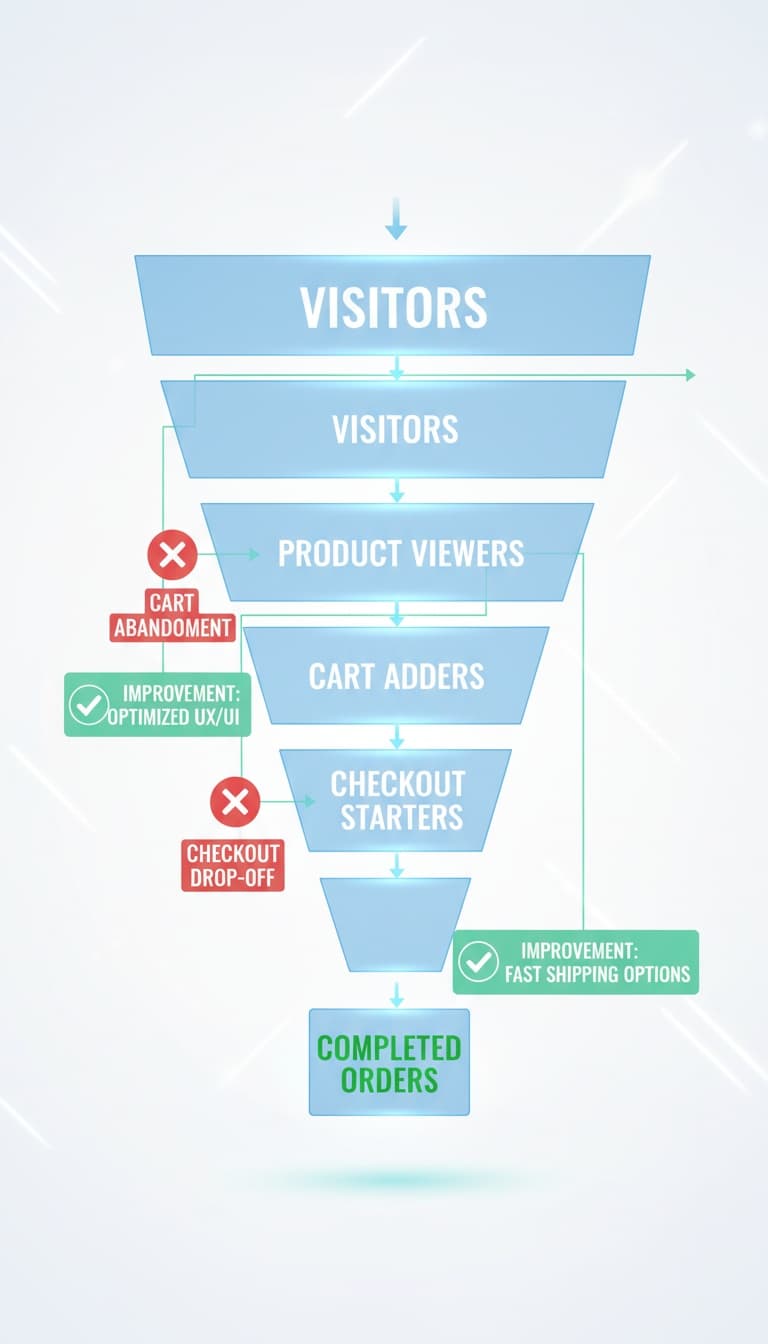Cart abandonment is one of the biggest leaks in any e-commerce funnel. Customers browse, add items, reach the checkout, then disappear without paying. Industry studies often show abandonment rates above sixty percent, which means the average store is leaving a huge amount of revenue on the table. The good news is that most abandonment is not random. It happens for repeatable reasons that you can identify and fix.
This guide shares fifteen proven methods to reduce cart abandonment in a practical way. You will learn how to remove friction, use trust badges, apply urgency in a healthy way, design better checkout UX, use remarketing flows, launch gamified offers, and add QR codes that bring customers back to their saved carts from offline moments.
Turn abandoned carts into recovered revenue
Use smart checkout UX, remarketing, and QR powered journeys to bring customers back to the carts they almost forgot.
Why shoppers abandon carts in e-commerce
Customers abandon carts for four main reasons. They encounter unexpected costs at checkout, they face too much friction, they lose trust or clarity, or they were only browsing and did not see a strong reason to complete the order. Many abandonment events are not final decisions. They are decisions to delay, which means you still have room to recover the sale.
Reducing cart abandonment is about stacking small improvements. No single tactic will fix everything, but a combination of smoother UX, better communication, relevant reminders, and creative re-engagement can lift conversion by several percentage points. This compounding effect can have more impact than many new acquisition experiments.

15 proven methods to reduce cart abandonment
1. Remove unexpected costs at the last step
Hidden costs are one of the most common reasons people abandon carts. When shipping, taxes, or fees appear only at the final step, customers feel misled and close the tab. The fix is simple. Show estimated totals early, provide a clear shipping calculator, and avoid surprise fees.
Where possible, offer transparent shipping rules such as free shipping above a clear threshold. Display this rule on product pages and in the cart. If you cannot offer free shipping, explain why your shipping is fair, for example because of premium packaging or faster delivery. Clarity reduces frustration and improves conversion.
2. Simplify your checkout into fewer steps
Every extra field and page in checkout creates drop off. Long forms feel like a chore. A multi step checkout can work, but each step must feel light and progress should be visible. If customers feel they are stuck in an endless process, they will abandon their cart.
Start by removing non-critical fields. Do you really need company name, second phone number, or separate address nickname? Use smart defaults, such as prefilled country based on IP and automatic city lookup by postal code. Show a progress indicator so customers know how close they are to completion.
3. Offer guest checkout instead of forcing account creation
Forced account creation is a high friction moment. Customers who only wanted to buy once do not always want to commit to a full account. Guest checkout solves this. It lets customers purchase with only essential information, then later you can invite them to create a password if they want richer benefits.
On top of guest checkout, you can offer perks for registered users such as saved addresses, order history, and loyalty points. Present these as optional value, not as a mandatory wall. This way you keep the door open for one time buyers while still building your logged in base over time.
4. Improve mobile checkout UX
Most e-commerce traffic is now mobile. If your checkout UX is not optimized for small screens, you will lose a large portion of potential orders. Problems include tiny fields, complex menus, poorly placed error messages, and heavy pages that load slowly on mobile networks.
Design mobile first. Use large tap targets, concise labels, and strong contrast. Place primary actions at the bottom where thumbs can reach them. Minimize typing by using address auto-complete and auto formatting for card numbers. Test your checkout on multiple devices and operating systems to catch layout issues.
5. Add trust badges and reassurance near payment fields
Customers hesitate to enter payment details if they are not fully confident about security and legitimacy. Trust badges, security icons, clear return policies, and visible contact information all reduce this anxiety. The location of these signals matters. They should be near the payment fields, not hidden in the footer.
Use recognizable security logos and short phrases such as secure checkout or thirty day returns. Show real contact options such as chat or email, plus links to reviews for social proof. These elements together reassure customers that the purchase is safe and reversible if something goes wrong.
6. Make shipping and returns policies obvious
Unclear shipping rules and confusing return policies cause hesitation. Customers wonder how long delivery will take, whether they will pay customs fees, or what happens if the product is not a fit. If they cannot find answers quickly, many will leave the cart.
Place summaries of shipping and returns directly on product pages and in the cart. Use short, plain language, with links to more detailed pages for those who want to read further. If you offer free returns or extended windows, highlight these benefits near the checkout button. Strong policies can act as selling points, not just compliance details.
7. Use urgency triggers carefully and honestly
Urgency can help customers make decisions when they are already interested but delaying. Tactics include limited time offers, low stock indicators, and timers for reserved carts. However, urgency must be used responsibly. Fake urgency erodes trust and can hurt long term retention.
Base urgency on real constraints. If stock is genuinely low, say only three left in your size. If an offer expires, link the countdown to your systems. Use urgency mainly for high intent customers who have already added items to a cart, not for cold visitors who have not yet decided whether the product is right for them.
8. Strengthen social proof near the cart
Social proof gives customers extra confidence that they are making a good decision. Place relevant reviews, ratings, and testimonials near the cart and checkout. Highlight comments that talk about reliability, delivery experience, and real life usage, not only that the product looks good.
You can also show small dynamic messages such as recently purchased or currently in carts when they are truthful and aggregated. These cues create a sense of activity and help customers feel less alone in their decision.
9. Let customers save and recover their carts easily
Many visitors abandon carts simply because life got in the way. They were interrupted, switched devices, or wanted to think before paying. Saving and recovering carts reduces the friction of returning. Customers should be able to leave and come back without rebuilding everything.
Implement persistent carts across sessions and devices, especially for logged in users. Offer an option to email the cart to themselves. You can also generate short links that open directly in the checkout with prefilled items. Solutions like VISU can associate these cart recovery links with QR based journeys to reconnect online and offline interactions.
10. Build smarter cart abandonment email flows
Cart abandonment emails are still one of the highest performing remarketing flows. A well timed reminder with a clear call to action can recover a meaningful percentage of lost revenue. The key is to be helpful, not spammy. Focus on value, not just urgency or discounting.
A simple sequence can include a first reminder within a few hours, a second message one or two days later with additional reassurance or FAQs, and an optional third message that shares reviews or alternative products if the original items are not available. Personalize subject lines and content with product names and images so customers immediately remember what they left behind.
11. Use SMS and push notifications for high intent reminders
SMS and push notifications can be effective for recovering carts when used with care. They should be reserved for customers who opted in and who showed strong intent, for example by reaching the payment step. Messages must be short, respectful, and timed appropriately for the customer region.
A typical SMS might say you left something in your cart and include a direct link to resume checkout. You can mention a friendly benefit such as free shipping threshold or a small loyalty bonus if they complete within a certain window. Always provide an easy opt out method to preserve trust.
12. Experiment with gamified offers instead of flat discounts
Flat discounts can recover some carts but quickly erode margin and train customers to wait for price drops. Gamified offers can create excitement without always giving away the maximum value. Examples include spin to reveal rewards, random bonuses, or tiered incentives based on cart size.
You might offer a small bonus for returning to the cart within a day, an extra reward for adding one more item, or loyalty points for completing checkout after scanning a QR code on an offline flyer. These mechanics can be managed through your loyalty and QR engagement stack so that rewards feel consistent across channels.

13. Offer modern payment methods and one tap wallets
Customers often abandon carts when they cannot use their preferred payment method. Missing digital wallets, local options, or installment plans create friction. Adding relevant methods can reduce drop off significantly, especially on mobile where typing card details is painful.
At minimum, support major cards and one tap wallets such as Apple Pay and Google Pay in markets where they are common. In certain regions, local payment systems can be critical. Place options clearly and in a logical order. If you test new methods, track their adoption and how they affect abandonment at the payment step.
14. Use QR codes to bring customers back to their carts from offline contexts
Customers often see your brand in multiple contexts: social feeds, physical stores, print campaigns, or product packaging. QR codes can connect these contexts back to saved carts and checkout pages. When scanned, a code can reopen the exact cart that a customer abandoned on another device or session.
For example, an abandoned cart email could include a QR code that customers scan to resume checkout on their phone. In store displays could show QR codes that load curated carts built around featured products. Product packaging or inserts could include codes that reopen a previous cart with refills or complementary items. Platforms like VISU make it possible to manage these QR journeys centrally while attributing which scans lead to recovered carts.

15. Analyze abandonment data and run continuous tests
Finally, a sustainable cart abandonment strategy depends on measurement and iteration. Aggregate analytics are not enough. You need to understand where and why customers drop off across steps and segments. Look at abandonment rates by device, geography, traffic source, and product category.
Run structured experiments. Test changes to shipping messages, field layouts, payment options, remarketing cadences, and QR based recovery journeys. Measure impact on completion rates, average order value, and long term retention. Over time, you will build a playbook of tactics that work best for your audience instead of relying on generic best practices.
Build a complete recovery system for your abandoned carts
Combine better checkout UX, remarketing flows, gamified offers, and QR based recovery to turn lost carts into predictable revenue.

